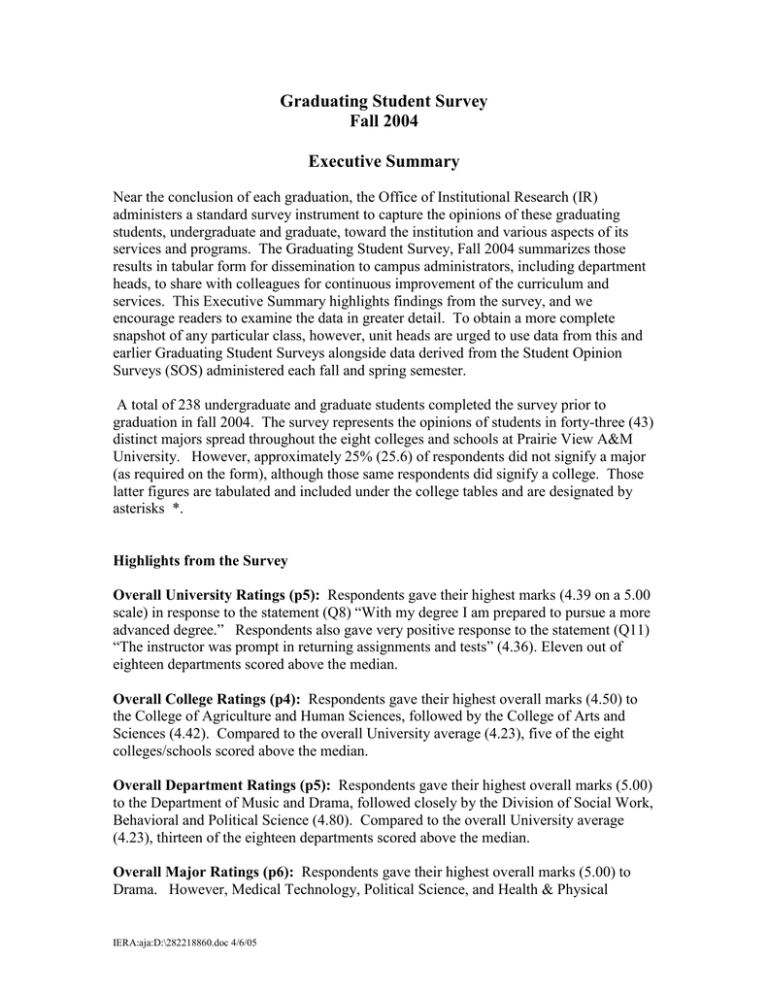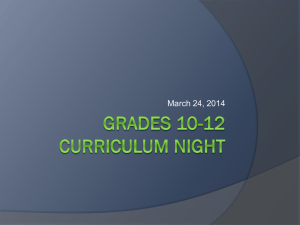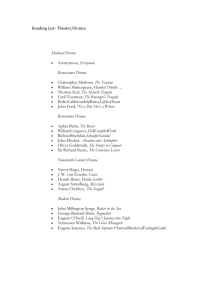Graduating Student Survey Fall 2004 Executive Summary
advertisement

Graduating Student Survey Fall 2004 Executive Summary Near the conclusion of each graduation, the Office of Institutional Research (IR) administers a standard survey instrument to capture the opinions of these graduating students, undergraduate and graduate, toward the institution and various aspects of its services and programs. The Graduating Student Survey, Fall 2004 summarizes those results in tabular form for dissemination to campus administrators, including department heads, to share with colleagues for continuous improvement of the curriculum and services. This Executive Summary highlights findings from the survey, and we encourage readers to examine the data in greater detail. To obtain a more complete snapshot of any particular class, however, unit heads are urged to use data from this and earlier Graduating Student Surveys alongside data derived from the Student Opinion Surveys (SOS) administered each fall and spring semester. A total of 238 undergraduate and graduate students completed the survey prior to graduation in fall 2004. The survey represents the opinions of students in forty-three (43) distinct majors spread throughout the eight colleges and schools at Prairie View A&M University. However, approximately 25% (25.6) of respondents did not signify a major (as required on the form), although those same respondents did signify a college. Those latter figures are tabulated and included under the college tables and are designated by asterisks *. Highlights from the Survey Overall University Ratings (p5): Respondents gave their highest marks (4.39 on a 5.00 scale) in response to the statement (Q8) “With my degree I am prepared to pursue a more advanced degree.” Respondents also gave very positive response to the statement (Q11) “The instructor was prompt in returning assignments and tests” (4.36). Eleven out of eighteen departments scored above the median. Overall College Ratings (p4): Respondents gave their highest overall marks (4.50) to the College of Agriculture and Human Sciences, followed by the College of Arts and Sciences (4.42). Compared to the overall University average (4.23), five of the eight colleges/schools scored above the median. Overall Department Ratings (p5): Respondents gave their highest overall marks (5.00) to the Department of Music and Drama, followed closely by the Division of Social Work, Behavioral and Political Science (4.80). Compared to the overall University average (4.23), thirteen of the eighteen departments scored above the median. Overall Major Ratings (p6): Respondents gave their highest overall marks (5.00) to Drama. However, Medical Technology, Political Science, and Health & Physical IERA:aja:D:\282218860.doc 4/6/05 2 Education-Health all tied with a 4.85 satisfaction rating, with Sociology close behind at 4.82. Areas of Highest Student Satisfaction (5.00) (p6): Respondents expressed high satisfaction with specific aspects of individual majors, as follows: Program met expectations (Q1) – Drama, Medical Technology, Political Science, H&PE, History, Computer Science, Elementary Education, Juvenile Forensic Psychology, Communications, Chemical Engineering, Interdisciplinary Studies, Architecture Courses well-developed and expertly taught (Q2) – Drama, Medical Technology, Political Science, H&PE, Sociology, Communications, Spanish, Civil Engineering As well-prepared in major as non-PVAMU graduates (Q3) – Drama, Medical Technology, Political Science, H&PE, Human Performance, Special Education, Computer Science, Elementary Education, Communications, Spanish, Electrical Engineering Technology, Marketing Job preparation (Q4) – Drama, Medical Technology, Political Science, H&PE, Sociology, Human Performance, History, Elementary Education, Communications, Spanish, Human Nutrition & Food, Marketing Faculty professionalism (Q5) – Drama, Medical Technology, Political Science, H&PE, Sociology, English, History, Architecture, Spanish, Communications-Journalism Academic Advisement (Q6) – Drama, Medical Technology, Political Science, Sociology, English, Architecture, Reading Education, Criminal Justice-Juvenile Justice Course grading (Q7) – Drama, Medical Technology, Political Science, H&PE, Sociology, English, History, Architecture, Reading Education, Juvenile Forensic Psychology, Communications, CommunicationsRadio/Television, General Engineering Pursuing advanced degree (Q8) – Drama, Medical Technology, Political Science, H&PE, Sociology, History, Special Education, Elementary Education, Communications, Human Science, Spanish, Electrical Engineering Technology, General Engineering, Civil Engineering, Family Nurse Practitioner Requiring use of library and other resources (Q9) – Drama, English, Special Education 3 Securing library and other resources (Q10) – Drama, Political Science, H&PE, History, Architecture, Juvenile Forensic Psychology, Family Nurse Practitioner Faculty and class evaluation (Q11) – Drama, Medical Technology, Political Science, H&PE, English, History, Special Education, Animal Science, Communications-Radio/Television, Communications-Journalism, General Engineering, Civil Engineering Recommend degree program (Q12) – Drama, Medical Technology, Political Science, H&PE, English, History, Special Education, Reading Education, Communications, Communications-Radio/Television, Electrical Engineering Technology, Civil Engineering Specialized equipment and computers available (Q13) – Drama, Medical Technology, H&PE, Sociology, Human Performance, History, Animal Science, Electrical Engineering Technology, Civil Engineering, Family Nurse Practitioner A Note on the Tables All tables in this survey assemble data gathered from 238 fall 2004 graduates. Each respondent rated his or her experience on a scale of 1 to 5, with 1 meaning “strongly disagree” and 5 meaning “strongly agree.” The scores were tabulated and separated by college, department, and major, but the reader should note that as the number of respondents per department/major varied significantly, a rating of 4.25 for one major does not necessarily equate to a 4.25 for another major. For example, twelve majors had only one respondent each, whereas no major had more than nine respondents. Sixty-one (61) respondents did not list a major. The single-digit number in each box on the table is the score marked by that individual respondent on the survey. Individual scores were then totaled and averaged (to two decimal places). The headings at the top of the table refer to each question, 1-13. “Code” is the three-digit major code. A complete copy of the survey and instrument is available at the IR Office website (“Graduating Student Survey, Fall 2004”). If you have any questions, please contact Dr. Gerald Gaither at the IR Office at X2448 or email ghgaither@pvamu.edu.






